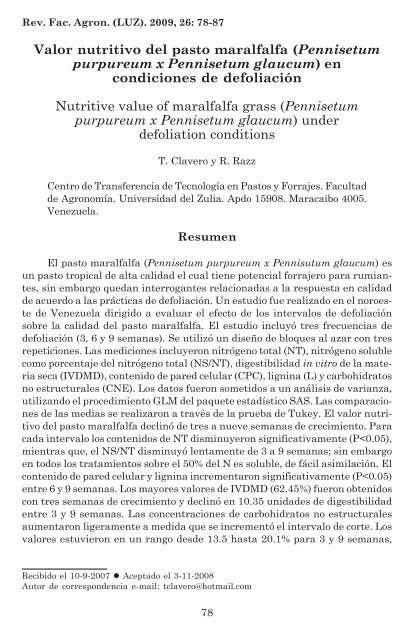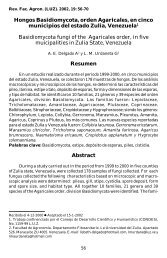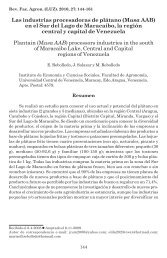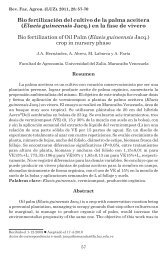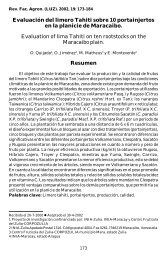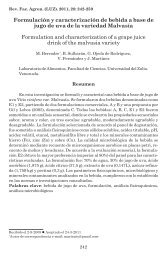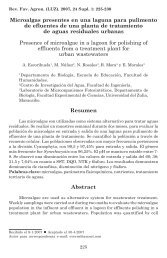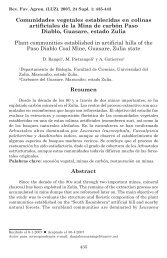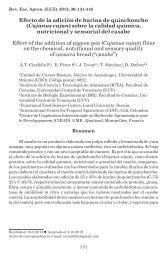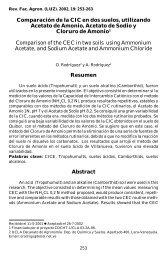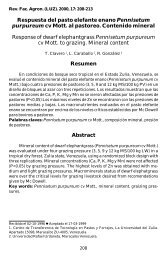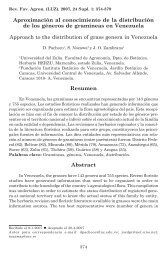Pennisetum purpureum x Pennisetum glaucum - Revista de la ...
Pennisetum purpureum x Pennisetum glaucum - Revista de la ...
Pennisetum purpureum x Pennisetum glaucum - Revista de la ...
Create successful ePaper yourself
Turn your PDF publications into a flip-book with our unique Google optimized e-Paper software.
Rev. Fac. Agron. (LUZ). 2009, 26: 78-87<br />
Valor nutritivo <strong>de</strong>l pasto maralfalfa (<strong>Pennisetum</strong><br />
<strong>purpureum</strong> x <strong>Pennisetum</strong> <strong>g<strong>la</strong>ucum</strong>) en<br />
condiciones <strong>de</strong> <strong>de</strong>foliación<br />
Nutritive value of maralfalfa grass (<strong>Pennisetum</strong><br />
<strong>purpureum</strong> x <strong>Pennisetum</strong> <strong>g<strong>la</strong>ucum</strong>) un<strong>de</strong>r<br />
<strong>de</strong>foliation conditions<br />
T. C<strong>la</strong>vero y R. Razz<br />
Centro <strong>de</strong> Transferencia <strong>de</strong> Tecnología en Pastos y Forrajes. Facultad<br />
<strong>de</strong> Agronomía. Universidad <strong>de</strong>l Zulia. Apdo 15908. Maracaibo 4005.<br />
Venezue<strong>la</strong>.<br />
Resumen<br />
El pasto maralfalfa (<strong>Pennisetum</strong> <strong>purpureum</strong> x Pennisutum <strong>g<strong>la</strong>ucum</strong>) es<br />
un pasto tropical <strong>de</strong> alta calidad el cual tiene potencial forrajero para rumiantes,<br />
sin embargo quedan interrogantes re<strong>la</strong>cionadas a <strong>la</strong> respuesta en calidad<br />
<strong>de</strong> acuerdo a <strong>la</strong>s prácticas <strong>de</strong> <strong>de</strong>foliación. Un estudio fue realizado en el noroeste<br />
<strong>de</strong> Venezue<strong>la</strong> dirigido a evaluar el efecto <strong>de</strong> los intervalos <strong>de</strong> <strong>de</strong>foliación<br />
sobre <strong>la</strong> calidad <strong>de</strong>l pasto maralfalfa. El estudio incluyó tres frecuencias <strong>de</strong><br />
<strong>de</strong>foliación (3, 6 y 9 semanas). Se utilizó un diseño <strong>de</strong> bloques al azar con tres<br />
repeticiones. Las mediciones incluyeron nitrógeno total (NT), nitrógeno soluble<br />
como porcentaje <strong>de</strong>l nitrógeno total (NS/NT), digestibilidad in vitro <strong>de</strong> <strong>la</strong> materia<br />
seca (IVDMD), contenido <strong>de</strong> pared celu<strong>la</strong>r (CPC), lignina (L) y carbohidratos<br />
no estructurales (CNE). Los datos fueron sometidos a un análisis <strong>de</strong> varianza,<br />
utilizando el procedimiento GLM <strong>de</strong>l paquete estadístico SAS. Las comparaciones<br />
<strong>de</strong> <strong>la</strong>s medias se realizaron a través <strong>de</strong> <strong>la</strong> prueba <strong>de</strong> Tukey. El valor nutritivo<br />
<strong>de</strong>l pasto maralfalfa <strong>de</strong>clinó <strong>de</strong> tres a nueve semanas <strong>de</strong> crecimiento. Para<br />
cada intervalo los contenidos <strong>de</strong> NT disminuyeron significativamente (P
Rev. Fac. Agron. (LUZ). 2009, 26: 78-87<br />
respectivamente. Este estudio indica que <strong>la</strong> calidad <strong>de</strong>l pasto maralfalfa es afectada<br />
negativamente a medida que avanza <strong>la</strong> madurez <strong>de</strong> <strong>la</strong> p<strong>la</strong>nta lo cual pue<strong>de</strong><br />
ser <strong>de</strong>bido a incrementos en <strong>la</strong> acumu<strong>la</strong>ción <strong>de</strong> material muerto en el perfil<br />
<strong>de</strong> <strong>la</strong> p<strong>la</strong>nta y <strong>la</strong> lignificación <strong>de</strong> <strong>la</strong>s pare<strong>de</strong>s celu<strong>la</strong>res. Esto sugiere que el pasto<br />
maralfalfa <strong>de</strong>be ser cosechado alre<strong>de</strong>dor <strong>de</strong> <strong>la</strong>s seis semanas <strong>de</strong> crecimiento <strong>de</strong><br />
manera <strong>de</strong> optimizar su valor nutritivo.<br />
Pa<strong>la</strong>bras c<strong>la</strong>ve: Pasto maralfalfa, valor nutritivo, <strong>de</strong>foliación.<br />
Abstract<br />
Maralfalfa grass (<strong>Pennisetum</strong> <strong>purpureum</strong> x <strong>Pennisetum</strong> <strong>g<strong>la</strong>ucum</strong>) is a high<br />
quality tropical grass which has potential as forage for ruminants but questions<br />
remain about quality response to <strong>de</strong>foliation management. A plot study<br />
un<strong>de</strong>rtaken on the tropical north west of Venezue<strong>la</strong> assessed the effect of<br />
<strong>de</strong>foliation interval on herbage quality of maralfalfa grass. The study inclu<strong>de</strong>d<br />
three <strong>de</strong>foliation frequencies (3, 6 and 9 weeks). Treatments were replicated<br />
three times in a randomized block <strong>de</strong>sign. Measurements inclu<strong>de</strong>d total nitrogen<br />
(TN), soluble nitrogen as % of total nitrogen (SN/TN), in Vitro dry matter<br />
digestibility (IVDMD), cell wall content (CWC), lignin (L) and total nonstructural<br />
carbohydrates (TNC). Data were subjected to analysis of variance,<br />
using general linear mo<strong>de</strong>ls procedures of SAS statistical package. Treatments<br />
means were contrasted using Tukey test. Nutritive quality of maralfalfa grass<br />
<strong>de</strong>clined from three to nine weeks of growth. At each interval TN, CP content<br />
<strong>de</strong>clined significantly (P
C<strong>la</strong>vero y Razz<br />
Latinoamérica (Colombia, Brasil y<br />
Venezue<strong>la</strong>, entre otros) <strong>de</strong>bido a su<br />
potencial como forraje para rumiantes<br />
(Correa, 2006; Moreno y Molina,<br />
2007).<br />
Pocas evaluaciones científicas se<br />
han realizado en este pasto <strong>de</strong> manera<br />
<strong>de</strong> <strong>de</strong>finir cuales son <strong>la</strong>s a<strong>de</strong>cuadas<br />
prácticas <strong>de</strong> manejo así como su<br />
potencial forrajero y valor nutritivo.<br />
Algunas investigaciones realizadas<br />
con genotipos <strong>de</strong> <strong>Pennisetum</strong> sp., <strong>de</strong>muestran<br />
que el pasto maralfalfa es<br />
una alternativa forrajera para aumentar<br />
<strong>la</strong> producción animal por su<br />
productividad <strong>de</strong> materia seca y valor<br />
nutritivo (Márquez et al., 2007).<br />
Por estas razones este estudio<br />
fue conducido <strong>de</strong> manera <strong>de</strong> evaluar<br />
<strong>la</strong> respuesta <strong>de</strong>l pasto maralfalfa a un<br />
rango <strong>de</strong> frecuencias <strong>de</strong> <strong>de</strong>foliación a<br />
objeto <strong>de</strong> obtener mayor información<br />
<strong>de</strong>l valor nutritivo y reservas <strong>de</strong>l material<br />
cosechado lo cual permitirá que<br />
este pasto sea utilizado con efectividad<br />
optimizando <strong>la</strong> persistencia <strong>de</strong>l<br />
pastizal y el momento óptimo <strong>de</strong> cosecha.<br />
Materiales y métodos<br />
Ubicación y caracterización<br />
<strong>de</strong>l área experimental. El estudio<br />
se realizó en una finca comercial ubicada<br />
en el Municipio Rosario <strong>de</strong><br />
Perijá, estado Zulia, al nor-oeste <strong>de</strong><br />
Venezue<strong>la</strong>. Des<strong>de</strong> el punto <strong>de</strong> vista<br />
agro ecológico, el sector es consi<strong>de</strong>rado<br />
como Bosque Seco Tropical, con<br />
precipitación promedio <strong>de</strong> 1100<br />
mm.año -1 , temperatura media anual<br />
<strong>de</strong> 29ºC, con evaporación media anual<br />
<strong>de</strong> 1600mm, a 100 msnm. El régimen<br />
pluviométrico es bimodal con mínimo<br />
countries of Latin America (Colombia,<br />
Brazil and Venezue<strong>la</strong>, among others)<br />
because its potential as forage for<br />
ruminants (Correa, 2006; Moreno and<br />
Molina, 2007).<br />
Few scientifical evaluations<br />
have been carried out about this grass<br />
for <strong>de</strong>fining which are the more<br />
a<strong>de</strong>quate management practices<br />
likewise its fod<strong>de</strong>r potential and<br />
nutritive value. Some researches<br />
ma<strong>de</strong> with genotypes of <strong>Pennisetum</strong><br />
sp., shows that Maralfalfa grass is a<br />
fod<strong>de</strong>r alternative for increasing the<br />
animal producton by its productivity<br />
of dry matter and nutritive value<br />
(Márquez et al., 2007).<br />
For these reasons this study was<br />
carried out with the purpose of<br />
evaluating the response of Maralfalfa<br />
grass to a rank <strong>de</strong>foliation frequencies<br />
in or<strong>de</strong>r to get information about<br />
nutritive value and reserves of<br />
harvest material which would permit<br />
that this grass be efectively used by<br />
optimizing pastizal persistance and<br />
the optimum moment of harvest.<br />
Materials and methods<br />
Location and characterization<br />
of experimental area. Study was<br />
carried out on a commercial farm<br />
located in Rosario <strong>de</strong> Perijá<br />
municipality, Zulia state, to the northwest<br />
of Venezue<strong>la</strong>. From the agro<br />
ecological point of view, the area is<br />
consi<strong>de</strong>red like tropical dry forest,<br />
with mean rainfall of 1100 mm.year -1 ,<br />
mean annual temperature of 29ºC,<br />
with mean annual evaporation of<br />
1600mm, to 100 msnm. Pluviometric<br />
regime is bimodal with a minimum on<br />
February and maximum on October<br />
80
Rev. Fac. Agron. (LUZ). 2009, 26: 78-87<br />
en el mes <strong>de</strong> Febrero y máximo en el<br />
mes <strong>de</strong> Octubre (COPLANARH,<br />
1974). Los suelos tienen una profundidad<br />
que va <strong>de</strong>s<strong>de</strong> 30-45 cm con pH<br />
<strong>de</strong> 6.4, taxonómicamente está c<strong>la</strong>sificado<br />
como Tipic Haplustult, con textura<br />
franco arenoso y una topografía<br />
principalmente p<strong>la</strong>na.<br />
Descripción <strong>de</strong>l experimento.<br />
El pastizal utilizado para el ensayo<br />
tenía un año <strong>de</strong> establecido, el cual se<br />
sembró con material vegetativo, con<br />
estacas <strong>de</strong> 25 cm colocadas horizontalmente<br />
en surcos superficiales, cubiertos<br />
3-4 cm y con distancia entre hileras<br />
<strong>de</strong> 1 m. Se aplicó una lámina <strong>de</strong><br />
riego <strong>de</strong> 60 mm en dos riegos semanales<br />
garantizándole los requerimientos<br />
hídricos al pastizal. El control <strong>de</strong> malezas<br />
se realizó <strong>de</strong> forma manual y <strong>la</strong><br />
fertilización con una fórmu<strong>la</strong> completa,<br />
(12-24-12) a razón <strong>de</strong> 250 kg.ha -1 ,<br />
que se aplicó al pastizal a fin <strong>de</strong> mantener<br />
el crecimiento activo.<br />
El experimento consistió en evaluar<br />
tres frecuencias <strong>de</strong> corte (3, 6 y 9<br />
semanas). Los tratamientos fueron<br />
arreg<strong>la</strong>dos en un diseño experimental<br />
<strong>de</strong> bloques al azar con tres repeticiones.<br />
Al inicio <strong>de</strong>l ensayo se le aplico<br />
un corte <strong>de</strong> uniformidad a 10 cm<br />
<strong>de</strong> altura. Posteriormente se estudiaron<br />
<strong>la</strong>s tres eda<strong>de</strong>s <strong>de</strong> corte por un<br />
periodo <strong>de</strong> 18 meses.<br />
Análisis químico. Se realizaron<br />
los siguientes análisis <strong>de</strong> <strong>la</strong>boratorio<br />
al material cosechado: nitrógeno<br />
total (NT) según métodos <strong>de</strong> análisis<br />
<strong>de</strong> <strong>la</strong> AOAC (1995), nitrógeno soluble<br />
(NS) por Richard y Van Soest<br />
(1977), pared celu<strong>la</strong>r (CPC) por Van<br />
Soest et al. (1991), digestibilidad in<br />
vitro <strong>de</strong> <strong>la</strong> materia seca (IVDMD) según<br />
Tilley and Terry modificado por<br />
(COPLANARH, 1974). Soils have a<br />
<strong>de</strong>ep that oscil<strong>la</strong>tes from 30-45 cm<br />
with pH of 6.4, taxonomically is<br />
c<strong>la</strong>ssified like Tipic Haplustult, with<br />
a sandy loam texture and a<br />
principally f<strong>la</strong>t topography.<br />
Experiment <strong>de</strong>scription.<br />
Grass<strong>la</strong>nd used for the essay had one<br />
year of being established, which was<br />
sowed with vegetative material, with<br />
stakes of 25 cm horizontally p<strong>la</strong>ced in<br />
superficial furrows, covered 3-4 cm and<br />
with a distance between rows of 1 m.<br />
An irrigation <strong>de</strong>pth of 60 mm was<br />
applied in two weekly irrigations to<br />
guarantee the hydrical requirements to<br />
grass<strong>la</strong>nd. Weeds control was ma<strong>de</strong> in<br />
manual way and fertilization with a<br />
complete formu<strong>la</strong>, (12-24-12) at a<br />
reason of 250 kg.ha -1 , which was applied<br />
to grass<strong>la</strong>nd for keeping active growth.<br />
Experiment consisted in<br />
evaluating three harvest frequencies<br />
(3, 6 and 9 weeks). Treatments were<br />
arrangement in an experimental<br />
<strong>de</strong>sign of random blocks with three<br />
replications. At the beginning of<br />
essay, a uniformity harvest was<br />
applied to 10 cm height. After, three<br />
frequencies were evaluated during a<br />
period of 18 months.<br />
Chemical analysis. The<br />
following <strong>la</strong>boratory ana,lysis were<br />
ma<strong>de</strong> to the harvested material: total<br />
nitrogen (TN) according analysis<br />
methods of the AOAC (1995), soluble<br />
nitrogen (SN) by Richard and Van<br />
Soest (1977), cell wall (CWC) by Van<br />
Soest et al. (1991), in vitro dry matter<br />
digestibility (IVDMD) acccording to<br />
Tilley and Terry modified by Van<br />
Soest (1975) and Non-structural<br />
carbohydrates (TNC) by Sniffen et al.<br />
(1992).<br />
81
C<strong>la</strong>vero y Razz<br />
Van Soest (1975) y carbohidratos noestructurales<br />
(CNE) por Sniffen et al.<br />
(1992).<br />
Análisis estadístico. Los datos<br />
se analizaron a través <strong>de</strong>l paquete<br />
estadístico SAS (1989), el análisis <strong>de</strong><br />
varianza se realizó a través <strong>de</strong>l GLM.<br />
Las medias se obtuvieron mediante el<br />
procedimiento <strong>de</strong> mínimos cuadrados,<br />
utilizándose <strong>la</strong> prueba <strong>de</strong> Tukey para<br />
<strong>la</strong> comparación <strong>de</strong> <strong>la</strong>s mismas.<br />
Resultados y discusión<br />
Se encontraron diferencias significativas<br />
en el valor nutritivo <strong>de</strong>l<br />
pasto maralfalfa por efecto <strong>de</strong> <strong>la</strong>s frecuencias<br />
<strong>de</strong> corte (cuadro 1). Los contenidos<br />
<strong>de</strong> nitrógeno total (NT) y<br />
digestibilidad in vitro <strong>de</strong> <strong>la</strong> materia<br />
seca (IVDMD) disminuyeron cuando<br />
se incrementaron los intervalos <strong>de</strong><br />
corte <strong>de</strong> 3 a 9 semanas. Durante este<br />
periodo, el NT y <strong>la</strong> IVDMD tuvieron<br />
diferencias <strong>de</strong> 1 y 10 unida<strong>de</strong>s entre<br />
los valores extremos <strong>de</strong> <strong>de</strong>foliación,<br />
respectivamente. Las concentraciones<br />
<strong>de</strong> NT y IVDMD obtenidas en este<br />
trabajo fueron inferiores a los valores<br />
reportados para el pasto elefante enano<br />
(<strong>Pennisetum</strong> <strong>purpureum</strong> cv Mott)<br />
Statistical analysis. Data<br />
were analyzed through the statistical<br />
package SAS (1989), the analysis of<br />
variance was ma<strong>de</strong> through GLM.<br />
Averages were obtained through<br />
minimum squares procedures, being<br />
used the Tukey test for its<br />
comparison.<br />
Results and discussion<br />
Significant differences were<br />
found in the nutritive value of<br />
Maralfalfa grass by effect of<br />
frequencies of harvest (table 1). The<br />
contents of total nitrogen (TN) and in<br />
vitro dry matter digestibility<br />
(IVDMD) <strong>de</strong>creased when cut<br />
intervals were increased from 3 to 9<br />
weeks. During this period, the TN and<br />
IVDMD had differences of 1 and 10<br />
units between <strong>de</strong>foliation extreme<br />
values, respectively. TN and IVDMD<br />
concentrations obtained in this<br />
research were inferior to those<br />
reported for the dwarf elephant grass<br />
(<strong>Pennisetum</strong> <strong>purpureum</strong> cv Mott) by<br />
C<strong>la</strong>vero and Ferrer (1995) to simi<strong>la</strong>r<br />
ages; however, like dwarf elephant<br />
grass, the rate of <strong>de</strong>crease of<br />
digestibility is low when the mature<br />
Cuadro 1. Valor nutritivo <strong>de</strong>l pasto maralfalfa.<br />
Table 1. Nutritive value of Maralfalfa grass.<br />
Frecuencia NT % CNE % NS/NT % IVDMD % CPC % L %<br />
(semanas)<br />
3 2.38 a 13.5b 70 a 62.45 a 55.60 c 6.1 b<br />
6 1.73 b 17.6a 63 b 55.75 b 59.55 b 6.7 b<br />
9 1.26 c 19.9a 51 c 52.10 b 62.95 a 7.4 a<br />
Medias con letras diferentes en <strong>la</strong> miasma columna difieren significativamente (P
Rev. Fac. Agron. (LUZ). 2009, 26: 78-87<br />
por C<strong>la</strong>vero y Ferrer (1995) a eda<strong>de</strong>s<br />
simi<strong>la</strong>res; sin embargo al igual que el<br />
elefante enano es baja <strong>la</strong> tasa <strong>de</strong> disminución<br />
<strong>de</strong> <strong>la</strong> digestibilidad a medida<br />
que <strong>la</strong> p<strong>la</strong>nta madura manteniendo<br />
valores mayores a los observados<br />
en el promedio <strong>de</strong> los pastos tropicales<br />
(C<strong>la</strong>vero, 2003).<br />
En cuanto al contenido <strong>de</strong> pared<br />
celu<strong>la</strong>r (CPC) y lignina (L) se observaron<br />
incrementos significativos al<br />
avanzar <strong>la</strong> edad <strong>de</strong> corte (cuadro 1).<br />
Cuando una p<strong>la</strong>nta madura existen<br />
cambios en <strong>la</strong>s proporciones <strong>de</strong> <strong>la</strong><br />
p<strong>la</strong>nta, presentándose una mezc<strong>la</strong><br />
heterogénea <strong>de</strong> hojas jóvenes, en <strong>de</strong>sarrollo,<br />
maduras, material muerto,<br />
tallos e inflorescencias, <strong>la</strong><br />
digestibilidad total <strong>de</strong> <strong>la</strong> masa<br />
forrajera estará en función <strong>de</strong> <strong>la</strong> proporción<br />
re<strong>la</strong>tiva <strong>de</strong> cada componente<br />
y <strong>de</strong> su digestibilidad individual.<br />
Cuando <strong>la</strong>s p<strong>la</strong>ntas son <strong>de</strong>foliadas frecuentemente<br />
(3 semanas), <strong>la</strong> mayor<br />
parte <strong>de</strong>l material cosechado son hojas<br />
jóvenes principalmente láminas,<br />
con gran cantidad <strong>de</strong> meristemos interca<strong>la</strong>dos<br />
en expansión los cuales<br />
presentan una elevada digestibilidad<br />
comparada a <strong>la</strong>s hojas totalmente expandidas.<br />
Así mismo, una vez que <strong>la</strong>s<br />
hojas se han expandido totalmente y<br />
el col<strong>la</strong>r aparece separando <strong>la</strong> lámina<br />
y <strong>la</strong> vaina, <strong>la</strong> digestibilidad <strong>de</strong>crece y<br />
es uniforme en toda <strong>la</strong> hoja. Cuando<br />
<strong>la</strong> p<strong>la</strong>nta no es cosechada, <strong>la</strong> acumu<strong>la</strong>ción<br />
<strong>de</strong> hojas viejas y material muerto<br />
exce<strong>de</strong> a <strong>la</strong> iniciación <strong>de</strong> nuevas<br />
hojas en <strong>la</strong> p<strong>la</strong>nta lo cual impacta negativamente<br />
en <strong>la</strong> digestibilidad <strong>de</strong>l<br />
material cosechado. La reducción en<br />
<strong>la</strong> digestibilidad con incrementos en<br />
madurez es también afectada por los<br />
aumentos en el contenido <strong>de</strong> compop<strong>la</strong>nt<br />
keeping values higher to those<br />
observed in the average of tropical<br />
grasses (C<strong>la</strong>vero, 2003).<br />
In re<strong>la</strong>tion to the cell wall<br />
content (CWC) and lignine (L)<br />
significant increases were observed<br />
when advancing the frequency of<br />
harvest (table 1). When a p<strong>la</strong>nt<br />
becomes mature, there are changes on<br />
p<strong>la</strong>nt proportions, by being showing<br />
an heterogenous mixture of young<br />
leaves, in <strong>de</strong>velopment, matures, <strong>de</strong>ad<br />
material, stems and inflorescences,<br />
the total digestibility of fod<strong>de</strong>r mass<br />
will be a function of the re<strong>la</strong>tive<br />
proporion of each component and its<br />
individual digestibility. When p<strong>la</strong>nts<br />
are frequently <strong>de</strong>foliated (3 weeks),<br />
the most of harvested material are<br />
young leaves specially b<strong>la</strong><strong>de</strong>s, with a<br />
high quantity of meristems inserted<br />
in expansion which shows a high<br />
digestibility compared to those leaves<br />
totally expan<strong>de</strong>d. Likewise, once<br />
leaves have been totally expan<strong>de</strong>d and<br />
the neck appears separated from<br />
b<strong>la</strong><strong>de</strong> and sheath, digestibility<br />
<strong>de</strong>crease and it is uniform in all the<br />
leaf. When p<strong>la</strong>nt is not harvested, the<br />
accumu<strong>la</strong>tion of old leaves and <strong>de</strong>ad<br />
material exceed to beginning of new<br />
leaves in p<strong>la</strong>nt which have a negative<br />
impact on digestibility of harvested<br />
material. Diminishing on digestibility<br />
with increases on maturity is also<br />
affected by the increases of structural<br />
components (CWC and L). Grasses of<br />
tropical origin in the first growth<br />
stages shows a thin cell wall, with low<br />
fiber, by permitting an easy breaking<br />
and short times of digestion. When<br />
maturity increases, the vascu<strong>la</strong>r<br />
structures of leaves become more<br />
thicks, like the vascu<strong>la</strong>r tissue and the<br />
83
C<strong>la</strong>vero y Razz<br />
nentes estructurales (CPC y L). Los<br />
pastos <strong>de</strong> origen tropical en los primeros<br />
estados <strong>de</strong> crecimiento presentan<br />
pared celu<strong>la</strong>r <strong>de</strong>lgada, con poca<br />
fibra, permitiendo una fácil ruptura<br />
y tiempos cortos <strong>de</strong> digestión. Cuando<br />
incrementa <strong>la</strong> madurez, <strong>la</strong>s estructuras<br />
vascu<strong>la</strong>res <strong>de</strong> <strong>la</strong>s hojas se hacen<br />
mas gruesas, así mismo el tejido<br />
vascu<strong>la</strong>r y el esclerénquima tanto <strong>de</strong><br />
<strong>la</strong>s hojas como los tallos se van<br />
lignificando haciéndose físicamente<br />
mas fuertes y difíciles <strong>de</strong> reducir en<br />
tamaño. A estas eda<strong>de</strong>s <strong>la</strong>s célu<strong>la</strong>s se<br />
unen fuertemente tanto vertical como<br />
<strong>la</strong>teralmente extendiéndose esos factores<br />
estructurales a capas <strong>de</strong>l<br />
esclerénquima vascu<strong>la</strong>r y en los tallos<br />
a <strong>la</strong>s célu<strong>la</strong>s <strong>de</strong>l parénquima entre<br />
los en<strong>la</strong>ces reduciendo los espacios<br />
intercelu<strong>la</strong>res como consecuencia <strong>de</strong><br />
lignificación entre capas y en<strong>la</strong>ces<br />
muy fuertes los cuales no dan puntos<br />
<strong>de</strong> quiebre e incrementan <strong>la</strong> resistencia<br />
a <strong>la</strong> digestión microbiana (Silva y<br />
Carvalho, 2005).<br />
El contenido <strong>de</strong> NT <strong>de</strong>clino a una<br />
tasa constante a medida que se incremento<br />
el intervalo <strong>de</strong> corte (cuadro 1).<br />
Estos resultados se encontraron <strong>de</strong>ntro<br />
<strong>de</strong> los valores reportados por<br />
Molina (2005) y Márquez et al. (2007)<br />
para este pasto, pero inferiores a los<br />
encontrados por Correa (2006) en<br />
maralfalfa cosechado a los 56 y 105<br />
días <strong>de</strong> rebrote.<br />
Esa reducción <strong>de</strong>l N se explica<br />
con lo reportado por Norton (1981)<br />
quien concluyó que <strong>la</strong> edad es el principal<br />
factor que afecta <strong>la</strong> concentración<br />
<strong>de</strong> N en <strong>la</strong>s partes <strong>de</strong> <strong>la</strong> p<strong>la</strong>nta.<br />
Esto es <strong>de</strong>bido a que con aumentos en<br />
<strong>la</strong> edad <strong>de</strong> <strong>la</strong> p<strong>la</strong>nta se reduce <strong>la</strong> re<strong>la</strong>ción<br />
lámina-vaina. Debido a que <strong>la</strong><br />
schlerenchyme of leaves and stems<br />
are lignified making themselves<br />
physically strongs and hard to be<br />
reduced in size. At these ages, cells<br />
are strongly vertically and <strong>la</strong>terally<br />
grouped, getting these structural<br />
factors to <strong>la</strong>yers of vascu<strong>la</strong>r<br />
schlerenchyme and in stems to cells<br />
of parenchyme between the links bty<br />
reducing intercellu<strong>la</strong>r spaces as a<br />
consequence of lignification between<br />
<strong>la</strong>yers and stronger links which do not<br />
give breaking points and increase<br />
resistence to microbial digestion (Silva<br />
and Carvalho, 2005).<br />
Content of TN <strong>de</strong>clined to a<br />
constant rate when the frequencies of<br />
harvest was also increased (table 1).<br />
These results were insi<strong>de</strong> values<br />
reported by Molina (2005) and<br />
Márquez et al. (2007) for this grass,<br />
but inferior to those found by Correa<br />
(2006) in Maralfalfa harvested<br />
between 56 and 105 regrowth days.<br />
This N reduction is exp<strong>la</strong>ined<br />
with those reported by Norton (1981)<br />
who conclu<strong>de</strong>d that age is the main<br />
factor that affect N concentration in<br />
p<strong>la</strong>nt parts when p<strong>la</strong>nt age increases,<br />
the b<strong>la</strong><strong>de</strong>-sheath re<strong>la</strong>tionship is also<br />
reduced. Because chlorop<strong>la</strong>sts protein<br />
is the higher protein proportion found<br />
in p<strong>la</strong>nt cells, the fact of the green<br />
portion of sheath have a higher N than<br />
those sheath fraction in<strong>de</strong>pen<strong>de</strong>nt of<br />
<strong>de</strong>velopment stage, it would not be<br />
amazing. When p<strong>la</strong>nt get old the<br />
sheath re<strong>la</strong>tionship increases, the <strong>de</strong>ad<br />
material and the shadow leaves. Like<br />
the chlorop<strong>la</strong>st number is higher in the<br />
proportion of leaves exposed to light,<br />
the N concentration will be high when<br />
sheats re<strong>la</strong>tionship in p<strong>la</strong>nt be also<br />
higher, it means, young p<strong>la</strong>nts.<br />
84
Rev. Fac. Agron. (LUZ). 2009, 26: 78-87<br />
proteína <strong>de</strong> los clorop<strong>la</strong>stos es <strong>la</strong> mayor<br />
proporción <strong>de</strong> proteína encontrada<br />
en <strong>la</strong>s célu<strong>la</strong>s <strong>de</strong> <strong>la</strong>s p<strong>la</strong>ntas, no<br />
<strong>de</strong>be sorpren<strong>de</strong>r que <strong>la</strong> porción ver<strong>de</strong><br />
<strong>de</strong> <strong>la</strong> lámina contenga mayor N que<br />
<strong>la</strong> fracción <strong>de</strong> <strong>la</strong> vaina in<strong>de</strong>pendiente<br />
<strong>de</strong>l estado <strong>de</strong> <strong>de</strong>sarrollo. Cuando <strong>la</strong><br />
p<strong>la</strong>nta envejece se incrementa <strong>la</strong> re<strong>la</strong>ción<br />
<strong>de</strong> vaina, incrementa el material<br />
muerto y <strong>la</strong>s hojas sombreadas.<br />
Como el número <strong>de</strong> clorop<strong>la</strong>stos es<br />
mayor en <strong>la</strong> porción <strong>de</strong> <strong>la</strong>s hojas expuestas<br />
a <strong>la</strong> luz, <strong>la</strong> concentración <strong>de</strong><br />
N será elevada cuando <strong>la</strong> re<strong>la</strong>ción <strong>de</strong><br />
láminas en <strong>la</strong> p<strong>la</strong>nta sea alta, es <strong>de</strong>cir<br />
p<strong>la</strong>ntas jóvenes.<br />
Las características <strong>de</strong> <strong>la</strong> fracción<br />
nitrogenada también se vieron afectadas<br />
con <strong>la</strong> edad <strong>de</strong> <strong>la</strong> p<strong>la</strong>nta. El NS<br />
como porcentaje <strong>de</strong>l NT disminuyó a<br />
mayor estado vegetativo. Indicando<br />
que parte <strong>de</strong>l N se asocia a <strong>la</strong>s pare<strong>de</strong>s<br />
celu<strong>la</strong>res y <strong>de</strong>más componentes <strong>de</strong><br />
<strong>la</strong> fracción insoluble <strong>de</strong> <strong>la</strong> fibra dietética.<br />
Sin embargo, por encima <strong>de</strong>l 50%<br />
<strong>de</strong>l N presente en el pasto maralfalfa<br />
es <strong>de</strong> fácil disponibilidad.<br />
Se observó en este experimento<br />
que <strong>la</strong> concentración <strong>de</strong> carbohidratos<br />
no estructurales incrementó como los<br />
intervalos se extendieron. Entre 3 y 9<br />
semanas, el promedio <strong>de</strong> <strong>la</strong>s concentraciones<br />
se incrementó en 48.8%.<br />
Reportes <strong>de</strong> literatura (C<strong>la</strong>vero,<br />
1993) re<strong>la</strong>cionan carbohidratos no<br />
estructurales (CNE) en órganos <strong>de</strong><br />
reserva con persistencia <strong>de</strong> <strong>la</strong>s p<strong>la</strong>ntas<br />
y rebrote <strong>de</strong>spués <strong>de</strong> <strong>la</strong> <strong>de</strong>foliación.<br />
Así mismo, indican que <strong>la</strong> habilidad<br />
<strong>de</strong> los pastos tropicales perennes <strong>de</strong><br />
rebrotar <strong>de</strong>spués <strong>de</strong> una <strong>de</strong>foliación<br />
severa <strong>de</strong>pen<strong>de</strong> en casi su totalidad<br />
<strong>de</strong> <strong>la</strong> cantidad <strong>de</strong> reservas <strong>de</strong> carbón<br />
disponible. Estas reservas <strong>de</strong> carbón<br />
Characteristics of nitrogenated<br />
fraction also were affected with p<strong>la</strong>nts<br />
age. The SN like TN percentage<br />
<strong>de</strong>creased to an elevated vegetative<br />
stage, by showing that part of N is<br />
re<strong>la</strong>ted to cell walls and the rest of<br />
components of insoluble fraction of<br />
dietetic fiber. Nevertheless, above<br />
50% of N present in Maralfalfa grass<br />
is easily avai<strong>la</strong>ble.<br />
In this experiment it was<br />
observed that non-structurals<br />
carbohydrates concentration<br />
increased when the intervals were<br />
exten<strong>de</strong>d. Between 3 and 9 weeks, the<br />
average of concentrations increased in<br />
48.8%.<br />
Literature reports (C<strong>la</strong>vero,<br />
1993) makes a re<strong>la</strong>tionship between<br />
non-structural carbohydrates (NSC)<br />
in reserve organs with p<strong>la</strong>nts<br />
persistence and regrowth after<br />
<strong>de</strong>foliation. They shows that ability of<br />
tropical grasses of regrowth after a<br />
severe <strong>de</strong>foliation <strong>de</strong>pend in almost its<br />
totallity of the avai<strong>la</strong>ble carbon reserves<br />
quantity. These reserves of carbon<br />
could be affected by frequent<br />
<strong>de</strong>foliations (3 weeks) because a<br />
reduction in foliar area which reduces<br />
the photosynthetic capacity and<br />
the possibility of acumu<strong>la</strong>te exce<strong>de</strong>nts<br />
of it. Also, <strong>de</strong>foliated p<strong>la</strong>nts with many<br />
frequency reduces the rhyzomes<br />
mass, with thin basal stems, superficial<br />
roots with little weight and<br />
<strong>de</strong>velop and increase on senescence of<br />
the radicle material, all this have an<br />
negative impact on carbohydrates<br />
concentration (C<strong>la</strong>vero, 1993; C<strong>la</strong>vero,<br />
2003). When these p<strong>la</strong>nts are<br />
<strong>de</strong>foliated with little frequency,<br />
increase the rhyzomes and other reserves<br />
accumu<strong>la</strong>tion areas likewise its<br />
85
C<strong>la</strong>vero y Razz<br />
pue<strong>de</strong>n afectarse por <strong>de</strong>foliaciones frecuentes<br />
(3 semanas) <strong>de</strong>bido a una reducción<br />
en área foliar <strong>la</strong> cual reduce<br />
<strong>la</strong> capacidad fotosintética y <strong>la</strong> posibilidad<br />
<strong>de</strong> acumu<strong>la</strong>r exce<strong>de</strong>ntes <strong>de</strong> <strong>la</strong><br />
misma. A<strong>de</strong>más, p<strong>la</strong>ntas <strong>de</strong>foliadas<br />
con mucha frecuencia reducen <strong>la</strong><br />
masa <strong>de</strong> rizomas, con tallos basales<br />
<strong>de</strong>lgados, raíces superficiales con menos<br />
peso y <strong>de</strong>sarrollo e incremento en<br />
<strong>la</strong> senescencia <strong>de</strong> material radicu<strong>la</strong>r,<br />
todo esto impacta en forma negativa<br />
en <strong>la</strong> concentración <strong>de</strong> carbohidratos<br />
(C<strong>la</strong>vero, 1993; C<strong>la</strong>vero, 2003). Cuando<br />
estas p<strong>la</strong>ntas son <strong>de</strong>foliadas con<br />
menos frecuencia, incrementan los<br />
rizomas y otras áreas <strong>de</strong> acumu<strong>la</strong>ción<br />
<strong>de</strong> reservas así como su área foliar<br />
residual incrementando su actividad<br />
fotosintética permitiendo una restauración<br />
<strong>de</strong> <strong>la</strong>s reservas <strong>de</strong> <strong>la</strong>s p<strong>la</strong>ntas<br />
con rangos <strong>de</strong> respuesta mínimas entre<br />
6 y 9 semanas.<br />
Conclusiones<br />
Con <strong>la</strong> información obtenida en<br />
esta investigación se pue<strong>de</strong> concluir que<br />
el pasto maralfalfa posee un valor nutritivo<br />
ligeramente superior al observado<br />
en <strong>la</strong> mayoría <strong>de</strong> los pastos tropicales.<br />
Valores <strong>de</strong> digestibilidad, nitrógeno<br />
total, NS/NT disminuyeron con <strong>la</strong><br />
edad mientras que valores <strong>de</strong> pared<br />
celu<strong>la</strong>r, lignina y carbohidratos <strong>de</strong> reserva<br />
incrementaron, lo cual no difiere<br />
<strong>de</strong> otros pastos tropicales actualmente<br />
utilizados en forma comercial. Sin embargo,<br />
el <strong>de</strong>crecimiento en IVDMD y N<br />
con <strong>la</strong> madurez <strong>de</strong> <strong>la</strong> p<strong>la</strong>nta es lento,<br />
no presentando mayores diferencias a<br />
eda<strong>de</strong>s entre 6 y 9 semanas.<br />
El valor nutritivo obtenido en este<br />
estudio indica que el pasto maralfalfa<br />
foliar residual foliar increasing its<br />
photosynthetic activity by permitting<br />
a reserves restore of p<strong>la</strong>nts with<br />
response ranks minimum between 6<br />
and 9 weeks.<br />
Conclusions<br />
With the information obtained<br />
in this research it can be conclu<strong>de</strong>d<br />
that Maralfalfa grass have a nutritive<br />
value lightly superior to those<br />
observed in the most of tropical<br />
p<strong>la</strong>nts. The digestibility values, total<br />
nitrogen, SN/TN <strong>de</strong>creased with age<br />
whereas values of cell wall, lignin and<br />
reserve carbohydrates increased,<br />
which not differs of another tropical<br />
grasses actually used in commercial<br />
way. Nevertheless, the <strong>de</strong>creasing on<br />
IVDMD and N with p<strong>la</strong>nt maturity is<br />
slow, do not show high differences at<br />
ages between 6 and 9 weeks.<br />
The nutritive value obtained in<br />
this research show that the<br />
Maralfalfa grass can be used in<br />
livestock production with animals in<br />
<strong>la</strong>ctation and in growth in where a<br />
fod<strong>de</strong>r material of medium to elevate<br />
quality.<br />
Results of this experiment<br />
shows that with non-structural<br />
carbohydrates reserves, the<br />
Maralfalfa grass can be persistent<br />
and survive to stress periods when is<br />
managed by using <strong>de</strong>foliation<br />
intervals equal or superior to 6 weeks.<br />
End of english version<br />
pue<strong>de</strong> utilizarse en producción gana<strong>de</strong>ra<br />
con animales <strong>la</strong>ctantes y en crecimiento<br />
don<strong>de</strong> se requiere un material<br />
forrajero <strong>de</strong> mediana a elevada calidad.<br />
86
Rev. Fac. Agron. (LUZ). 2009, 26: 78-87<br />
Resultados <strong>de</strong> este experimento<br />
indican que con <strong>la</strong>s reservas <strong>de</strong><br />
carbohidratos no estructurales, el<br />
pasto maralfalfa pue<strong>de</strong> ser persistente<br />
y sobrevivir a periodos <strong>de</strong> estrés<br />
cuando se maneja con intervalos <strong>de</strong><br />
<strong>de</strong>foliación iguales o superiores a <strong>la</strong>s<br />
seis semanas.<br />
Literatura citada<br />
AOAC. Association of Oficial Analytical<br />
Chemists. 1995.16th ed.<br />
Arlington, UA. 684 pp.<br />
C<strong>la</strong>vero, T. 1993. Efectos <strong>de</strong> <strong>la</strong> <strong>de</strong>foliación<br />
sobre los niveles <strong>de</strong> carbohidratos<br />
no estructurales en pastos <strong>de</strong><br />
origen tropical. Rev. Fac. Agron.<br />
(LUZ). 10:126-132.<br />
C<strong>la</strong>vero, T. 2003. Pasto elefante enano<br />
(<strong>Pennisetum</strong> <strong>purpureum</strong> cv Mott):<br />
Biología, agronomía y utilización<br />
en <strong>la</strong> alimentación animal. Centro<br />
<strong>de</strong> transferencia <strong>de</strong> tecnología <strong>de</strong><br />
pastos y forrajes. Maracaibo,<br />
Venezue<strong>la</strong>. 76 pp.<br />
C<strong>la</strong>vero T. y O. Ferrer. 1995. Valor<br />
nutritivo <strong>de</strong>l pasto elefante enano<br />
(<strong>Pennisetum</strong> <strong>purpureum</strong> cv Mott).<br />
Rev. Fac. Agron (LUZ). 12:365-372.<br />
COMISION DE PLAN NACIONAL DE<br />
APROVECHAMIENTO DE LOS<br />
RECURSOS HIDRAULICOS<br />
(COPLANARH). 1974. At<strong>la</strong>s:<br />
Inventario Nacional <strong>de</strong> Tierras.<br />
Región <strong>la</strong>go <strong>de</strong> Maracaibo.<br />
Venezue<strong>la</strong>. 91 pp.<br />
Correa, H. 2006. Calidad nutricional <strong>de</strong>l<br />
pasto maralfalfa (<strong>Pennisetum</strong> sp)<br />
cosechado a dos eda<strong>de</strong>s <strong>de</strong> rebrote.<br />
Livestock Research for Rural<br />
Development. 18(6):2006. (En<br />
linea). http://www.cipav.org.co/<br />
Irrd/Irrd18/6/corr18084.htm<br />
Márquez, F., J. Sánchez, D. Urbano y C.<br />
Dávi<strong>la</strong>. 2007. Evaluación <strong>de</strong> <strong>la</strong><br />
frecuencia <strong>de</strong> corte y tipos <strong>de</strong><br />
fertilización sobre tres genotipos<br />
<strong>de</strong> pasto elefante (<strong>Pennisetum</strong><br />
<strong>purpureum</strong> ). 1. Rendimiento y<br />
contenido <strong>de</strong> proteína. Zootecnia<br />
tropical. 25(4): 253-259.<br />
Molina, S. 2005. Evaluación agronómica<br />
y bromatológica <strong>de</strong>l pasto<br />
maralfalfa (<strong>Pennisetum</strong> sp.)<br />
cultivado en el valle <strong>de</strong>l Sinu. Rev.<br />
Fac. Nac. Agron. Colombia.<br />
58(1):39-45.<br />
Moreno, F. y D. Molina. 2007. Buenas<br />
practicas agropecuarias en <strong>la</strong><br />
producción <strong>de</strong> ganado <strong>de</strong> doble<br />
propósito bajo confinamiento con<br />
caña panelera como parte <strong>de</strong> <strong>la</strong><br />
dieta. MANA-FAO. Impresión<br />
CTP Print Ltda. Colombia. 139 p.<br />
Norton, B. 1981. Differences between<br />
species in forage quality. In: J.<br />
Hacker (ed.). Nutricional limits to<br />
animal production from pastures.<br />
Commonwealth Agric. Bureaue,<br />
Farnham Royal, UK., 89-110 .<br />
Silva S. y P. Carvalho. 2005. Foraging<br />
behavior and herbage intake in<br />
the favorable tropics/subtropics.<br />
In: D. A. McGilloway(ed.)<br />
Grass<strong>la</strong>nd: a global resource.<br />
Wageningen Aca<strong>de</strong>mia publishers<br />
The Nether<strong>la</strong>nds, 81-95.<br />
Richard, G. y P. Van Soest. 1977. Protein<br />
solubility of ruminant feeds. Proc.<br />
Cornell Nutr. Conf. Department of<br />
Animal Science. Cornell<br />
University. Itheca, NY. P. 91.<br />
SAS. Statistical Analysis System Institute.<br />
1989. User´s gui<strong>de</strong>. 4th ed. Vol. 2.<br />
846 pp.<br />
Sniffen, C., J. Connor, P. Van Soest, D.<br />
Fox y J. Russell. 1992. A net<br />
carbohydrate and protein system<br />
for evaluating cattle diets. II.<br />
Carbohydrate and protein<br />
avai<strong>la</strong>bility. J. Anim. Sci. 70:2562-<br />
2567.<br />
Van Soest, P. 1975. Forage fibre análisis.<br />
Agricultura Handbook Nº 379.<br />
Agricultural Research Serv. US<br />
Dep. Agricultura, USA.<br />
Van Soest, P. J. Robertson y A. Lewis.<br />
1991. Methods for dietary fiber,<br />
neutral <strong>de</strong>tergent fiber and<br />
nonstarch polysacchari<strong>de</strong>s in<br />
re<strong>la</strong>tion to animal nutrition. J.<br />
Dairy Sci. 74:3583-3597.<br />
87


